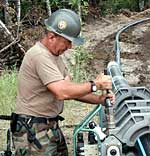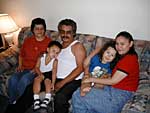Operation Walking Shield
By Tom Robertson, Minnesota Public Radio
August 6, 2001
Some 500 Red Lake Reservation families are on a waiting list to move into tribal homes. Many have been on the list for years. Now tribal housing officials are teaming up with the U.S. military to try to solve at least part of the problem, with the help of an organization called Operation Walking Shield.
PEACE AND QUIET is rare in Julie and Keith Stately's Red Lake home.
"There's my husband and me and we have two daughters and two grandchildren, and then my daughter's husband and my other daughter's boyfriend. They all stay here. And then there's my grandson; he stays here quite a bit. So there's nine of us in the house. it get's pretty stressful here. Sometimes we have to maybe take a ride or just get away for awhile," Julie Stately says.
The Stately's daughter has been on a housing waiting list for two years, and they don't expect she'll move to the top anytime soon. They know of other band members who've been waiting twice that long, and other homes even more overcrowded, with as many as 21 people living in a space designed for a family of four.
Tribal Chairman Bobby Whitefeather calls the housing situation critical, and says it's partly because the reservation population's phenomenal growth. "Families that had left the reservation or families that are descendants of families that left the reservation are deciding to move back and be a part of the community, whereas in urban settings they kind of lost touch with their identity sometimes - their culture for sure, and a lot of them want to recapture that or reconnect," Whitefeather says.
Red Lake is getting some help with their housing problem from the U.S. military.
About a dozen Navy Seabee reservists have begun work on a three-year, $10 million project that includes construction of seven miles of roads, sewer and water infrastructure, and creation of a new housing community. Fifty surplus homes will come from the Grand Forks Air Force Base, and soldiers will build eight more.
By next year, several hundred people from just about every major branch of the military will join the effort. The pairing of military resources with needy Indian reservations is the job of a non-profit group called the Walking Shield American Indian Society.
"The focus is a civil military cooperative effort between the military and the reservations to do projects on reservations that enhance the military training and skills, while providing meaningful improvements for the Indian people," says organization coordinator Gary Doll.
Walking Shield was created in 1986 by Phil Stevens, a Lakota Indian who saw an urgent need for housing on reservations across the country.
"There's been abominable neglect of the housing needs of the American Indians. There are over 100,000 new houses that are required, and there are 133,000 deplorably substandard houses that are available on our Indian reservations," Stevens says.
The Red Lake project is the largest ever undertaken by Walking Shield, and organizers say it will be a model for future efforts. Unlike typical reservation housing projects - cookie-cutter homes lined up side by side - the new homes will be set on heavily wooded, two-acre sites. Tribal officials say the design and landscape will be much more suitable to the Ojibwe lifestyle.
Chairman Whitefeather says given his people's past history with the U.S. military, the Red Lake Tribal Council initially had mixed feelings about having federal troops within reservation borders. But he says members decided it was a win-win situation.
"The practice of rebuilding nations around the world has gone on for decades, and too many times rebuilding Indian nations was never even thought about. And so, maybe as a beginning here, that demonstration of good faith and good will by the United States military is something that's long overdue," Whitefeather says.
Walking Shield has already rehoused more than 3,000 American Indians, helped build or repair more than 700 miles of roads, including some on the White Earth and Leech Lake reservations in northern Minnesota, and has coordinated health care and medical support to more than 20,000 Indians by military doctors, dentists and nurses. The Red Lake project is expected to be completed by fall of 2003.
By Tom Robertson, Minnesota Public Radio
August 6, 2001
|
|
RealAudio |
Some 500 Red Lake Reservation families are on a waiting list to move into tribal homes. Many have been on the list for years. Now tribal housing officials are teaming up with the U.S. military to try to solve at least part of the problem, with the help of an organization called Operation Walking Shield.
| |
|
|
|
||
The Stately's daughter has been on a housing waiting list for two years, and they don't expect she'll move to the top anytime soon. They know of other band members who've been waiting twice that long, and other homes even more overcrowded, with as many as 21 people living in a space designed for a family of four.
Tribal Chairman Bobby Whitefeather calls the housing situation critical, and says it's partly because the reservation population's phenomenal growth. "Families that had left the reservation or families that are descendants of families that left the reservation are deciding to move back and be a part of the community, whereas in urban settings they kind of lost touch with their identity sometimes - their culture for sure, and a lot of them want to recapture that or reconnect," Whitefeather says.
Red Lake is getting some help with their housing problem from the U.S. military.
About a dozen Navy Seabee reservists have begun work on a three-year, $10 million project that includes construction of seven miles of roads, sewer and water infrastructure, and creation of a new housing community. Fifty surplus homes will come from the Grand Forks Air Force Base, and soldiers will build eight more.
By next year, several hundred people from just about every major branch of the military will join the effort. The pairing of military resources with needy Indian reservations is the job of a non-profit group called the Walking Shield American Indian Society.
"The focus is a civil military cooperative effort between the military and the reservations to do projects on reservations that enhance the military training and skills, while providing meaningful improvements for the Indian people," says organization coordinator Gary Doll.
| |
|
|
|
||
The Red Lake project is the largest ever undertaken by Walking Shield, and organizers say it will be a model for future efforts. Unlike typical reservation housing projects - cookie-cutter homes lined up side by side - the new homes will be set on heavily wooded, two-acre sites. Tribal officials say the design and landscape will be much more suitable to the Ojibwe lifestyle.
Chairman Whitefeather says given his people's past history with the U.S. military, the Red Lake Tribal Council initially had mixed feelings about having federal troops within reservation borders. But he says members decided it was a win-win situation.
"The practice of rebuilding nations around the world has gone on for decades, and too many times rebuilding Indian nations was never even thought about. And so, maybe as a beginning here, that demonstration of good faith and good will by the United States military is something that's long overdue," Whitefeather says.
Walking Shield has already rehoused more than 3,000 American Indians, helped build or repair more than 700 miles of roads, including some on the White Earth and Leech Lake reservations in northern Minnesota, and has coordinated health care and medical support to more than 20,000 Indians by military doctors, dentists and nurses. The Red Lake project is expected to be completed by fall of 2003.


